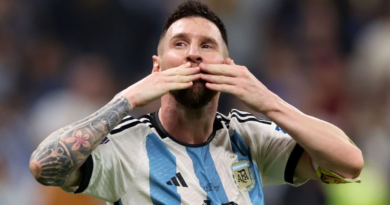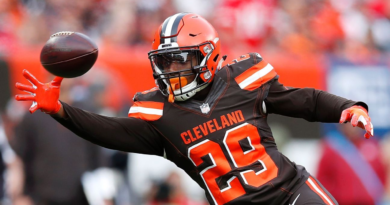Fantasy baseball: Tout Wars mixed Roto league draft recap
It’s a brand new game. One only has to turn on any baseball telecast from either the Cactus League or Grapefruit League to notice that the bases are a little bit bigger, infielders are firmly planted on the infield dirt, two to each side of second, and a lot of attention is being paid to the clock which counts down the time between pitches. Yes, for the 2023 season, MLB has added some new rules that have changed the way the game will be played.
Well, things are no different here at ESPN. In the spirit of innovation, we’ve also made some changes to the way our standard game is being played. For our points format, wins and losses no longer have as much fantasy impact, while middle relievers are now rewarded for getting the job done with each hold earning a pair of points. Plus, across the board (points and roto), starting lineups have been streamlined to more closely resemble that of a major league team, with roster size scaled back to allow for more depth on the fantasy waiver wire.
Of course, there are always going to be purists who prefer their fantasy baseball to keep its “original recipe” intact. Yes, there are fantasy managers out there who like playing full-season rotisserie with 23-man lineups (including five outfielders, a middle infielder, a corner infielder, two catchers and nine pitchers). These are leagues where you need to know the name of the fifth outfielder on the Pittsburgh Pirates, just in case you need to draft him for your bench in Round 28.
Let the Tout Wars begin!
While I’m certainly excited about the change in store for 2023, I also enjoy the “classic” game as well, which is why I was honored to be invited to take part in a 15-team expert league run by Tout Wars.
This is an old school rotisserie league with starting lineups that include: 5 outfielders, 2 catchers, 1 second baseman, 1 shortstop, 1 middle infielder (either 2B or SS), 1 first baseman, 1 third baseman, 1 corner infielder (either 1B/3B), 1 DH/utility player (defined as a player who may play any non-pitching position), 9 pitchers (who may be either starters or relievers). In addition, teams also draft a six-player reserve bench, made up of players at any position.
The categories used to rank teams in this league are as follows: On-base percentage, total home runs, total RBI, total runs scored and total stolen bases for hitters and WHIP (walks plus hits divided by innings pitched), ERA, total wins, total saves and total strikeouts.
Here’s a brief glimpse into what I was thinking as I sat in the draft room to select my team on Tuesday, March 7. I was assigned the No. 14 pick in the snake, so I had to wait quite a bit before making my first selection.
Rounds 1-2
With such a late pick, you know right off the bat you’re not going to get the likes of Aaron Judge, Trea Turner, Julio Rodriguez, Juan Soto, Ronald Acuna Jr. or Freddie Freeman. You also know that once you do make your first two picks (14th and 17th overall), you won’t get to make any other selections until a total of 43 players have been removed from consideration. With that in mind, I planned to take some power and one of the top five shortstops since I feel there’s a huge drop-off after that tier.
When my clock finally started, Shohei Ohtani was still on the board, so I didn’t think I could pass him up. Now, the caveat on Ohtani in this league is that he is split up into two separate players — you either draft “Ohtani the hitter” or “Ohtani the pitcher,” but you have to choose. I went with his bat, hoping for a healthy 40-HR/100-RBI season. (Ohtani’s arm ended up being selected early in Round 4, using a “nobody is going to draft this guy” placeholder on the draft board, which is why you’ll see Janson Junk listed as the No. 48 overall pick.)
After Fernando Tatis Jr. got selected with the last pick of the first round, the path was then clear for me to welcome Bo Bichette to my infield. Don’t worry, we’ll have plenty of time for our meet-and-greet as the snake winds its way slowly through the next 27 picks.
Rounds 3-6
Experience in leagues of this size has taught me that, while there always seems to be some opportunity to find hitting stats on the waiver wire once the regular season starts, if you don’t get enough solid pitching early on, you’re pretty much eliminated from the competition out of the gate. That’s why my goal with this portion of the draft was to claim as many starting pitchers from my personal top 25 as possible and, since saves count for 20% of your pitching value, a top-five closer as well.
I was hoping one of those names could have been Spencer Strider or Max Scherzer, but neither lasted to me in Round 3. And, Devin Williams got snaked from me one pick prior to my Round 5 selection. Still, I won’t complain with the quartet of Dylan Cease, Julio Urias, Framber Valdez and Ryan Pressly as the foundation of my staff.
Rounds 7-10
With five required outfield spots, I knew I wanted to take two if possible over this stretch of the proceedings, so I grabbed power with Anthony Santander and OBP with Brandon Nimmo. I don’t typically like to be “reactionary” with my picks, but with there being a two-catcher requirement, I didn’t want to wait any longer once a run on the position started, hence my MJ Melendez pick here. Finally, in keeping with my plan to “draft one pitcher with every four picks” from this point forward, I was thrilled to be able to add Lucas Giolito, a top-30 SP value at the tail end of Round 9.
Rounds 11-15
It’s here in the middle round of the draft where it behooves you to no longer pay any attention to what the other fantasy managers are doing. Some teams have avoiding pitching and need to go heavy in that direction. Others have gone heavy on the outfield or maybe filled up all three corner spots and now need to set their sights up the middle.
The point is, for now, you need to get the best available options at the positions you still need to fill and simply do that until you have a viable starting lineup. With that in mind, I selected Ke’Bryan Hayes (20 steals last season), Triston Casas (someone who I saw play last year at Triple-A and who looked to be 100% ready for the jump), and Josh Rojas (likely top-10 steals guy who should be around a .350 OBP) to fill out my infield. Sexy? Nope, but it will do the job in a 15-teamer.
Rounding out this section of the draft, I grabbed Kendall Graveman for saves, at least I’m hoping for them to come early in the season. Sure, we all want to see Liam Hendriks return, but there’s no guarantee as to when exactly that might happen. Finally, I went with the multi-positonal DJ LeMahieu, who could well lead off for the Yankees this season.
Rounds 16-20
There’s not much to say here in terms of “strategy” as we enter the endgame of the 23-man roster portion of the draft. It’s more filling in the blanks, with the aim towards upside and potential should everything go right. I fully expect two of these picks to be absolute busts, but which ones will actually be the disappointments? Who knows?
Oscar Colas could potentially break camp as the starting right fielder for the White Sox, but he is still a rookie, albeit one with professional experience in Japan. Noah Syndergaard still hasn’t completely regained his velocity, two years removed from Tommy John surgery. Shea Langeliers has power for days, but hit just .218 in his 40 games with the Athletics last season, with a 34.6% K rate. That needs to improve.
Speaking of strikeouts, here’s Joey Gallo, who is an undraftable commodity in points leagues due to the deduction for each whiff. In roto, an out is merely an out. I’m really just hoping here that the new rules outlawing the shift allow Gallo to be a bit better in terms of his plate discipline. And finally, was Dylan Carlson‘s disastrous 2022 just the result of thumb and wrist injuries or is he simply one of those “done before he got started” kind of players? We shall see.
Rounds 21-29
Last in, first out. When it comes to the last spot or two in your starting lineup and your bench, you can’t think too hard about it. After all, these are the guys you’re going to cut first when you see something better on the waiver wire or if a spate of injuries forces you to switch out some of your current dead weight in exchange for a warm body who at least has eligibility at a position of need.
I still needed a corner infielder, so I essentially took three bites at the apple with a trio of younger guys who could end up with a starting job on Opening Day: Brett Baty, Spencer Steer and Nolan Jones (who could be needed in the infield after all the post-Brendan Rodgers juggling is done).
Beyond that, it’s just speculation on some injury risks on the mound (Spencer Turnbull, James Kaprielian), solid late-inning relievers who might get the odd “vulture win” or occasional save as the season goes along (A.J. Minter, James Karinchak) and a few extra “you never know” outfield selections, since five healthy slots is always going to be an uphill climb to fill over the course of a 162-game season (Lane Thomas, Kevin Kiermaier).
In the end, I’m fairly optimistic with my team, provided I don’t once again get hit by the injury bug (last season, at one point in mid-May, I had 13 players on IL). Either way, draft day is just the beginning of the story and not the final chapter. We’ll have to see how our team does out of the gate, making adjustments to what’s not working by using trades and the waiver wire, and hoping for the best as we strive for an upper-half of the league finish. Anything beyond that is just gravy.
AJ’s 2023 Tout Wars mixed-league roster (15-team roto)
-
Catchers: MJ Melendez, Shea Langeliers
-
Infielders: Triston Casas, Josh Rojas, Bo Bichette, Ke’Bryan Hayes, DJ LeMahieu, Brett Baty
-
Outfielders/UT: Shohei Ohtani, Anthony Santander, Brandon Nimmo, Oscar Colas, Joey Gallo, Dylan Carlson
-
Pitchers: Dylan Cease, Julio Urias, Framber Valdez, Lucas Giolito, Noah Syndergaard, Spencer Turnbull, Ryan Pressly, Kendall Graveman, A.J. Minter
-
Reserve: Lane Thomas, Nolan Jones, James Karinchak, James Kaprielian, Spencer Steer, Kevin Kiermaier
Note: To see all Tout Wars mixed-league rosters, head here.




